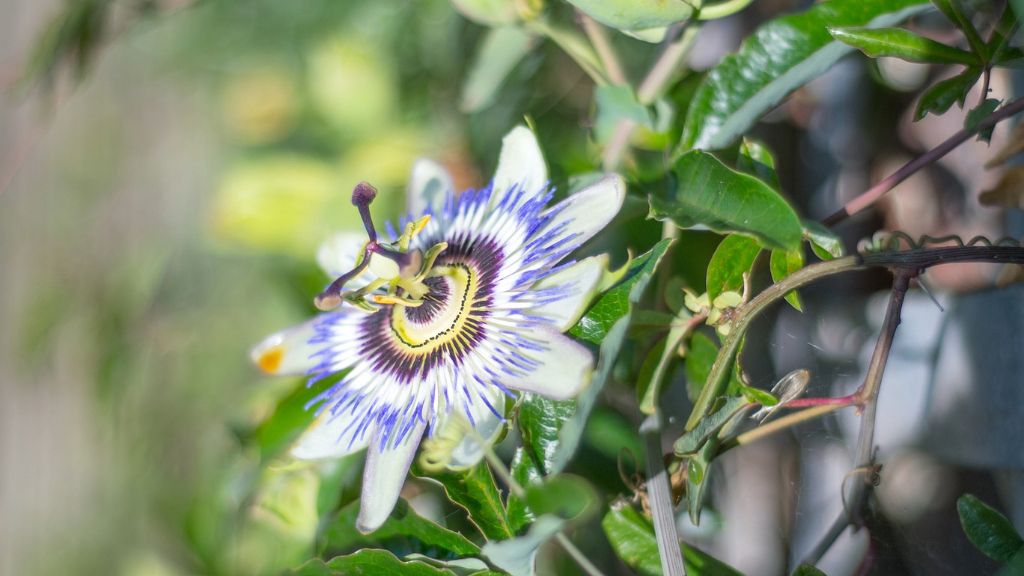Top 10 Questions About Passion Flower Vines


Gardening Know How is here to help with all your gardening questions, and when it comes to growing and caring for passion flower vines, it's no different. If you have a passion for plants, then no doubt passion flower is on that list. While we receive a number of inquiries regarding these plants, here are the 10 most commonly asked questions about passion flowers.
1. How do you start or grow a passion flower plant?
Passion flower is pretty easy to start. If you have an existing plant, or know a friendly neighbor gardener who does, you can take a cutting. Cut off a 4- to 6-inch (10 to 15 cm.) piece of stem just below a node. Take off the bottom leaves and dip the end of the stem in rooting hormone and then potting soil. Keep it warm and moist and out of direct sunlight. You can also start passion flower from seed. Score seeds gently with sandpaper and soak them in warm water for 24 hours. Put the seeds in soil to a depth of about a quarter inch (0.5 cm.) and keep covered with plastic. Put the seedlings in sunlight once you see leaves.
2. Why are passion flower leaves turning yellow?
Watering issues are most likely to blame for yellowing passion flower leaves. Check the soil and provide extra water if it is dry and if the conditions have been especially hot. If the soil is consistently moist and it isn't too hot, you may need to back off on watering.
3. Why are there no flowers on my passion flower vine?
There are likely some environmental issues preventing your vine from blooming. Passion flower actually prefers not to be fertilized, so if you have been feeding it, stop. Sunlight can also be a problem. The vine needs full sun to bloom, so consider transplanting if necessary. The soil around the roots should be moist but also must drain well. Overwatering and underwatering could prevent blooms. Your vine may also simply be too young to flower. Most passion flower plants will take a few years to establish before flowering.
4. How to prune a passion flower vine?
Prune a passion flower vine regularly to promote thicker growth and flower and fruit production. During late winter, remove any damaged or dead stems. Then, cut back stems in general by about a third of the plant. The vine will come back more vigorously and fuller. If you have an old, overgrown vine, you can prune it back to life. Cut it back to just a few strong stems. New stems should come in, and you can train these to develop a nice, tidy vine.
5. Can I grow passion flower in a pot?
Yes, passion flower can grow well in a container. But, in order to thrive it, will need a large pot. Regularly transplant it to a bigger pot as the plant grows. Watering in a container is especially important. You may need to water more often, but also be sure that the pot drains. Whether in a container or in the ground, your passion flower will need full sunlight.
6. Why is passion fruit shriveling and dropping off?
There are a few potential problems that can cause passion fruit to drop early. An irregular watering schedule may trigger the issue. Passion flower vine needs regular watering but also good drainage. Cold temperatures can be a problem too, as can pests. Mite damage may cause fruit drop, as can fruit vine hoppers. Check for and manage any infestations. Finally, a lack of trace elements in the soil may cause fruit to drop. Get your soil tested through the local extension office to find out if it's missing anything.
Gardening tips, videos, info and more delivered right to your inbox!
Sign up for the Gardening Know How newsletter today and receive a free copy of our e-book "How to Grow Delicious Tomatoes".
7. Can you grow passion flower outside in winter?
It depends on where you live. Passion flower vine is considered hardy outdoors in USDA zones 6 to 9. It may be fine in zone 5, but that's pushing it. If your temperatures get down to the negative double digits Fahrenheit (about -24 and lower Celsius), the vine probably will not survive the winter. You can, however, overwinter the plant indoors.
8. How to control passion flower vines?
Many people plant passion flower intentionally, but it can also be an invasive plant, especially wild varieties. If you need to eliminate or control vines, first try pulling out new growth. If you want to get rid of all of the vines, you'll need to dig out the roots using a shovel. Any remaining roots will regrow. Alternatively, you can use herbicides. Those with picloram, dicamba, or 2,4-D, triclopyr should work with this woody vine.
9. When to harvest passion fruit and how to plant seeds?
The color of the fruit will change when it ripens, but it depends on the variety. Ripe passion fruit will also drop from the vine. If you harvest the seeds, start germinating them when fresh. Score the seeds with sandpaper and soak them in warm water for about 24 hours. Then you can start them as you would other seeds: in a seed tray with moist potting soil. Keep the seeds moist and then place in sunlight once leaves emerge.
10. Can passion flower be transplanted?
You can transplant a passion flower vine, but it can be difficult. The roots go deep, and you'll need to dig most of them out for a successful move. The best time to attempt a transplant is in late winter or early spring before active growth begins for the new season. Dig out the roots when the soil is moist to make it easier. Make sure to plant the roots as deeply as they were in the original location for the best results.
We all have questions now and then, whether long-time gardeners or those just starting out. So if you have a gardening question, get a gardening answer. We're always here to help.

Mary Ellen Ellis has been gardening for over 20 years. With degrees in Chemistry and Biology, Mary Ellen's specialties are flowers, native plants, and herbs.
-
 Best Tomatoes For Containers: 10 Tastiest Varieties For Plentiful Produce In Compact Areas
Best Tomatoes For Containers: 10 Tastiest Varieties For Plentiful Produce In Compact AreasThese are the best tomatoes for containers that prove you don't need to have a large space or elaborate garden to grow delicious produce.
By Bonnie L. Grant
-
 Ultimate Potted Flowers For Spring: 8 Brilliant Blooming Options for Spring Containers
Ultimate Potted Flowers For Spring: 8 Brilliant Blooming Options for Spring ContainersCelebrate the most uplifting of seasons with the most dazzling container flowers imaginable. Here, we present some of the loveliest potted flowers for spring…
By Tonya Barnett